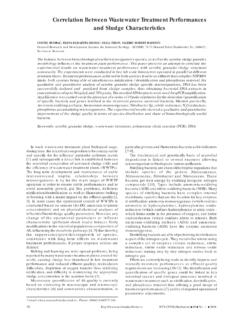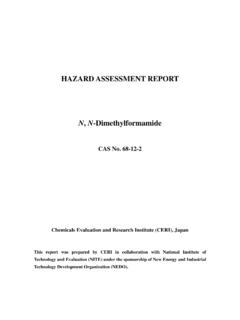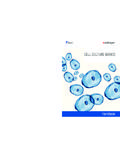Transcription of Researches on the Chemical Composition and the …
1 (Bucharest) 69 No. 1 201870 Researches on the Chemical Composition and the RheologicalProperties of Wheat and Grape Epicarp Flour MixesOANA BIANCA OPREA1, LIVIA APOSTOL2, SIMONA BUNGAU3*, GABRIELA CIOCA4*, ALINA DORA SAMUEL5, MIHAELA BADEA1,LIVIU GACEU11 Transilvania University of Brasov, 29 Eroilor Blvd., 500036, Brasov, Romania2 National Research & Development Institute for Food Bio resources - IBA Bucharest, 6 Dinu Vintila Str., 0211202, Bucharest,Romania3 University of Oradea, Faculty of Medicine and Pharmacy, 29 Nicolae Jiga Str., 410028, Oradea, Romania4 Lucian Blaga University of Sibiu, Faculty of Medicine, 10 Victoriei Blvd., Sibiu, 550024, Romania5 University of Oradea, Faculty of Sciences, 1 Universitatii Str., 410087, Oradea, RomaniaGrape skin is considered a valuable by-product for antioxidant and antibacterial agent preparation. Thegrape skin contains some active compounds, such as, dietary fiber, polyphenols, flavonols, and resveratrol;it is commonly used as a nutritional supplement.
2 The main aim of this study was to establish the optimumdose of grape skin flour, to be used as a functional ingredient in the bakery products industry, from bothchemical and rheological point of view. The laboratory experiments evaluated the functional potential ofwheat flour enriched with grape skin flour, in different proportions, by examining the Chemical compositionand rheological behaviour of the doughs. Protein, crude fibre, fat, ash and mineral contents were H-NMR spectral technique, the fatty acids Composition was determined, especially the concentrationsof short-chain saturated fatty acids (C4-C8), di-unsaturated fatty acids, mono-unsaturated fatty acids andlong-chain saturated fatty acids (>C8). 1H-NMR spectra were recorded on a Bruker Ascend 400 MHzspectrometer. The rheological behaviour was analyzed using the predefined Chopin + protocol on Mixolab,an equipment of CHOPIN Technologies.
3 Grape skin flour was incorporated into wheat flour at three differentlevels, 5, 10 and 15% and it was found that incorporation up to a 15% level into the formulation of wheat flouryielded an acceptable product in terms of rheological parameters, with improved Chemical , nutritional andfunctional : bakery, crude fibre, functional ingredient, grape skin, dough, rheological properties * email: All the authors had equal contribution at this original articleVitis vinifera (common grape vine) is a species of Vitis,native to the Mediterranean region, central Europe, andsouthwestern Asia, from Morocco and Portugal north tosouthern Germany and east to northern Iran. There arecurrently between 5,000 and 10,000 varieties of Vitisvinifera grapes though only a few are of commercialsignificance for wine and table grape archaeological discoveries revealed that wine-making dated back about 7,000 years ago, in a Neolithicvillage located in Iran s northern Zagros Mountains, beinguntil now the earliest evidence of wine-making [1].
4 Nowadays grapes are among the most valuedconventional fruits in the world and 80% of the grape yieldis used for wine-making. The wine-making industriesproduce millions of tons of residues (grape seeds and skin)after fermentation, which represents a waste managementissue both ecologically and economically [2]. Theproductive use of such by-products could offer substantialeconomic and health by-products (grape seeds and skin) contain activecompounds, such as, dietar y fibre [3], antioxidants:polyphenols (flavonoids, antocianosides etc.) [4-9], whichare of growing interest to researchers [10-13], because oftheir linkage to human health. This content varies widely,depending on many factors: varieties of the species, soilqualities and its management [14-23], weather conditionsin which the plant lives: precipitation, climate, sunny days/year, pollution in the area of culture (especially waste waterand inadequate management of different types of wastes[24-29]), conditions for obtaining and preserving thefinished product, technology used, etc.
5 [30,31].Several studies have shown that many bioactivecomponents in grape seeds and skin have been shown toprevent a wide array of chronic disorders linked tometabolic syndrome [32]. Grape seeds and skin flour, apolyphenol rich mixture containing flavonoids, nonflavonoids, oligomeric proanthocyanidins, is commonlyused as a nutritional supplement [33].Recent research has demonstrated that grape seedscatechins protect rat cortical astrocytes against palmiticacid-induced lipotoxicity [34].Due to the abundance of natural polyphenolicsubstances, grape seeds are widely used for the treatmentof prostate deficits [35]. It is demonstrated that grape seedshave anti-inflammatory benefits [36], scavenging freeradicals, inhibiting lipid peroxidation, anti-carcinogenic andso forth [37]. Some studies found that grape seed-derivedpolyphenols extract (GSP) had prostatic protective naturein vivo and could modulate prostatic oxidative stress[38,39].
6 Because of the increased attention to sustainable ofagricultural practices, there is a vast array of applicationsfor grape pomace, such as functional food (dietary fibreand polyphenols), food processing (biosurfactants),cosmetic (grape seeds oil and antioxidants),pharmaceutical and supplements (grape pomace powder)[40-42].The importance of knowing the grape pomacecomposition enables us to find the industrial uses [43] andto evaluate the importance of the raw material variability[44] on the final application. Despite a substantial numberof studies using grape pomace for different applications, (Bucharest) 69 No. 1 2018 reality they are often ineffective as they are notsuccessfully implemented in larger scales [45].However the use of suitable by-products (such as wineresidues) as functional ingredients has the advantage thatfood manufacturers can add extra value to food products,but the main factors that have to be considered are thevariations affecting the processing conditions, the sensoryproperties, and the nutritional value of the final products could represent a potential candidatefor the addition of this functional ingredients, but theirnutritional profile has to be improved in view of formulatingfunctional products.
7 Several Researches have been directedto reduce fats, sugars, and energy level [46-48] of this typeof products, and to improve the quality of raw materials,respectively [49].The objective of this work was to characterize mixturesof wheat flour and grape skin flour through a physico- Chemical evaluation of the rheological properties , whichare the main quality attributes of these mixtures for use partMaterialsGrapes skin flour, a by-product obtained duringmanufacture of red Vitis vinifera from Romania, wasfurnished by a local wine-making factory. Grape skins werecollected after the grapes were crushed and the grape juicewas obtained. Fresh samples were manually sieved toseparate skin fraction from the seeds. Skin fraction wasdried and ground. The level of degradation of thecomponents of this material may be considered lowbecause all the steps were performed at low flour used in the study was 480 type (ash, ) and was provided by Titan (Bucharest,Romania).
8 Preparation of wheat flour mixtures enriched in bioactivecompoundsThree types of mixtures of 650 type wheat flour (ash, - ) and different proportions of defatted grapeseeds flour were obtained, in the following ratios: 95:5,90:10, and 85:15 (w/w). The types of flour mixtures usedin this study are presented in table [50]) in muffle furnace at 450-5000C. Crude proteincontent was calculated by multiplying total nitrogencontent by the factor Crude fibers include cellulose,hemicellulose, and lignin. The crude fiber content of thesamples was determined using a method for determination of crude fibers beginswith treating the sample with an acid detergent solution(20 g N-cetyl-N,N,N-trimethylammonium bromidedissolved in 1 L H2SO4 M). In this solution, cellulose andlignin from the analysed material are insoluble, unlike allother components. Using special FibreBags, the dilutionand filtration steps are simplified.
9 The most importantaspects of this method of analysis of the fibers areadherence to strict boiling times and to treatment with the acid detergent solution, theinsoluble residue is dried, weighed and then burnt. The aciddetergent fiber (ADF) content represents the insoluble partof the sample that is left after boiling in acid detergentsolution from which the ash obtained upon calcination issubtracted, and it is given by the equation:Blank value ( )= where: - mass of FiberBag (g), - sample mass (g), - mass of crucible and dried FibreBag, after digestion (g), - mass of crucible and and ash (g), - blank value ofempty FiberBag (g), - mass of crucible and ash of theempty FiberBag (g), - mass of crucible (g).Carbohydrate contents were calculated as the differenceof 100-(ash+protein+fat+moisture). Each sample wasanalysed in content analysisMineral content was determined using an atomicabsorption spectrophotometer (ContrAA 700; AnalitykJena).
10 Total ash was determined by incineration at 550 0C,in an oven. Analysis was performed using an externalstandard (Merck, multi element standard solution) andcalibration curves for all minerals were obtained using 6different concentrations. Dried samples were digested inconcentrated acids profileUsing H-NMR spectral technique, fatty acidscomposition was determined, especially theconcentrations of short-chain saturated fatty acids (C4-C8),di-unsaturated fatty acids, mono-unsaturated fatty acidsand long-chain saturated fatty acids (> C8). 1H-NMR spectrawere recorded on a Bruker Ascend 400 MHz spectrometer,operating at Tesla corresponding to the resonancefrequency of MHz for the 1H nucleus. Samples wereanalyzed in 5 mm NMR tubes (Wilmad 507). The NMRsamples were prepared by dissolving mL oil in mLCDCl3. The Chemical shifts are reported in ppm, using theTMS as internal properties evaluationThe rheological behavior of doughs was analyzed usingthe predefined Chopin + protocol on Mixolab, a newequipment of CHOPIN Technologies [51].



